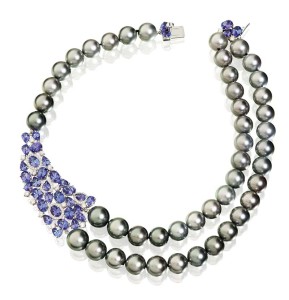Valuation criteria for a pearl
There are many assessment techniques and criteria used to value a cultured pearl, but what they must all take into account is that beauty equals quality—the more beautiful the pearl, the higher its quality. There are four basic factors that define a pearl’s quality: lustre, surface, shape, and colour.
Lustre

Lustre describes the level of intensity and beauty of the light reflected by the pearl and refracted by the nacre layer. For excellent lustre, a pearl must be formed by a thick layer of high-quality nacre. Nacre is the pearly substance made of organic and inorganic materials secreted by a particular tissue in the mollusk.
A pearl consists of hundreds of layers of nacre covering the nucleus. Each layer is composed of thousands of ‘microscopic tiles’ overlapping in a surprisingly uniform arrangement. The infinite possible compositions of the nacre tiles lead to considerable differences in appearance between pearls and the elusive beauty of a gem’s inner glow or its ‘orient,’ which is an iridescent effect. The more perfect the composition of the tiles and their arrangement, the more exceptional the reflections produced by the nacre.
Lustre is the most important of the four factors used to determine a pearl’s quality, and by extension, its value. The price of a pearl depends on its grade of lustre, which is described using the following scale:
A”“Excellent: Very high, almost metallic lustre, produced by a thick, high-quality nacre with excellent refractive properties.
B”“Good: High, non-metallic lustre—which is evidence of a thick layer of nacre—although with lesser refractive properties.
C”“Fair: Thinner, lower-quality nacre than the first two grades, with less refractive brilliance. As a result, lustre is a little more opaque.
D”“Poor: Possesses a layer of poor-quality nacre that does not refract light to any satisfactory degree. Pearls of this grade are not generally sold.
Surface
A pearl’s surface is the second most important factor influencing its value. Like emeralds, most pearls possess various birthmarks. Surface appearance is generally classified according to the following grades:
1″“No visible blemish: Such pearls are used for the highest class of jewellery or on strands of extraordinary beauty and quality.
2″“Small blemishes: The pearl exhibits slight imperfections.
3″“Numerous blemishes: The surface displays many imperfections or deep blemishes, though if the pearl has high lustre, it is ideal for medium-quality jewels, original pieces with emphasis on design, or reasonably priced strings.
4″“Very obvious blemishes: The entire surface of the pearl shows imperfections, deep blemishes, and marks.





